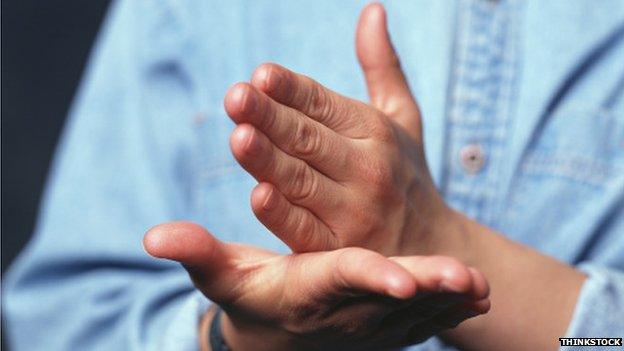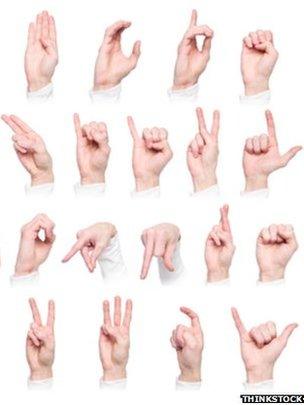Lesser-known things about deafness
- Published
- comments

Beyond being unable to hear, there's quite a lot about deaf people and culture that non-deaf people may be unaware of. Here are five lesser-known things from those in the know.
How have advancements in technology helped people who are deaf?
It wasn't so long ago that deaf people had to use Royal Mail to arrange to meet up for a drink and hope their letter hadn't got lost in the post, so technology such as basic SMS texting has taken the "hit and miss" away from life if you can't hear.
Twenty years ago most people were dependent on phone calls to chat, talk at work, or to do business. This was a problem for deaf people, many of whom find it impossible to hear voices on telephone lines.
Around this time were innovations such as the textphone which allowed deaf people to type to one another with their words appearing on a screen, and many deaf people bought fax machines to exchange messages quickly.
The internet too has been transformative for how deaf people communicate, many are avid users of social networks like Facebook where they set up groups, create events or campaign for better rights.
For those whose preferred language is BSL, it's easy to sign or lip-read to each other via video services on the internet. Those all-important status updates can contain videos in which people sign about how their day has been. Video is often used for more formal reasons, such as getting in touch with companies to enquire about services.
Hearing aids and cochlear implants are becoming more sophisticated. Sound can be made much clearer with the use of Bluetooth connections to phones or music players. New inventions claim to be able to translate between BSL and English, automatically capturing, interpreting and creating sign language.
Do all deaf people sign?
No. The number of people who use British Sign Language (BSL) as their first language is often estimated to be around 70,000 people, though the British Deaf Association says the figure is more like 150,000. It's thought that over 800,000 people in the UK are severely or profoundly deaf and certainly there are many deaf people who do not use BSL.
Sign language users often identify themselves as being part of the "Deaf" community, taking pride in using BSL and being part of a "Deaf" culture rather than being lowercase-d "deaf", which describes those for whom the hearing loss aspect dominates.
Many deaf people continue to use English as their first language. They may wear hearing aids or cochlear implants to make the most of the hearing they have, and use helpful communication like lip-reading instead of learning sign. Other alternatives include Sign Supported English (where you sign many of the spoken English words unlike BSL which is a language with its own grammar and order) or cued speech (lip-reading enhanced by gestures to explain the sounds that can't be easily read from the lip movements).
Are sign languages the same across the world?
Sign languages vary from country to country. There are significant differences between BSL and American Sign Language (ASL) for example, including even the basic English alphabet which is conveyed by the fingers and known as fingerspelling. In the UK, we use two hands for this while Americans use one hand.

International Sign is used to communicate with people who sign in a different language
There are regional differences in BSL, as there are in most languages, because of how sign language evolved over the years in deaf clubs and schools around the country.
For example, the BSL Corpus Project found that while "a deaf person living in Bristol may sign the number six with their little finger, a deaf person living in London may sign the number six with their thumb."
At international conferences or events like the Deaflympics, deaf people can use International Sign which employs iconic universally understood gestures to help bridge the language barrier.
One unique facet of sign language is that many deaf people have sign names which are mostly created by their friends and are often related to something personal like an interest or habit they might have. So, for example, someone who talks a lot could be given the sign name Waffle.
Is it easy to lip-read?
Crime dramas often depict deaf people lip-reading across rooms, or working out what murder suspects are saying on CCTV, but the harsh reality is that around 70% of lip-reading is guesswork. This means it's easy for deaf people to make mistakes, or get very tired after concentrating hard on someone's mouth.
Most deaf people have an embarrassing story of something they misunderstood in public, much to the hilarity of everyone around them. For example, it's well known in deaf circles that mouthing the words "elephant's shoes" without making a vocal sound looks remarkably similar to saying "I love you" if you're lip-reading.
The good news is that the more practice deaf people have, the better they get at lip-reading. Some deaf people have even made a good living from lip-reading celebrities at major events, such as the World Cup, or the Royal Wedding.
And how many deaf people are there in the UK?
More than most people think. Deafness is often described as being the 'invisible disability,' because it's not immediately obvious to people that someone is deaf - unless they spot their hearing aids or see them signing. It's estimated that one in six people are deaf to some degree which translates as 10 million people in the UK. Numbers are set to rise, with Action on Hearing Loss expecting them to reach 14.5 million by 2031 - they attribute this number to people listening to loud music on portable music players.
Charlie Swinbourne is a deaf journalist and editor of The Limping Chicken, a popular blog which looks at deaf issues from a personal perspective.
Follow @BBCOuch, external on Twitter and on Facebook, external, and listen to our monthly talk show